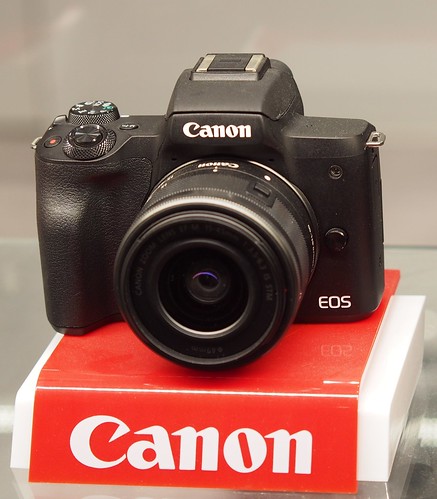Canon EOS M50

|
| Canon EOS M50 image by Uwe Kulick (Image rights) |
The EOS M50 (named the EOS Kiss M in Japan) is a mirrorless interchangeable-lens camera (MILC) with a 24.2-million pixel APS-C CMOS sensor, made by Canon in 2018. By using the 'EOS Kiss' name, Canon signalled that they regard it as an entry- to enthusiast-level camera. The layout of its controls, and the provision of a 75mm (3 inch) tilt-and-swivel screen, make the M50 strikingly like the PowerShot G12, only with interchangeable lenses and an EVF instead of an optical finder.
The native frame of the camera is 3:2 (with a maximum image being 6000x4000 pixels); 4:3, 16:9 and 1:1 (square) are also available.
The camera uses Canon's Digic 8 processor. It has a 'hybrid' focal-plane shutter (Electronic First-Curtain Shutter - EFCS), used on all the EOS M cameras except the M6 mk II.[1] At very high shutter speeds this may give rise to non-uniform exposure; the wave-front of activation takes a finite time to pass across the sensor, and this is actually slower than the closing shutter. At very short exposure times, the difference in exposure between the top and bottom of the frame may become significant. With a single shutter blind, the alternative of using the same mechanical blind to begin and end exposure also has disadvantages, and is louder. The M50 has a 'silent shutter' feature in which exposure is both started and finished electronically.
Autofocus is mostly carried out using phase-detection: contrast-detection AF is used for video.
An updated model, the EOS M50 Mark II (EOS Kiss M2) was produced in November 2020. It is very similar to the original. The major difference is in metering, which is effective over the range LV -2 to 20, compared to the original camera's range LV 0 to 20. Autofocus works to LV -4, instead of LV -2 in the original camera. The Mark II also has greater estimated battery life than the original, with the same LP-E12 Li-ion battery; for example taking 250 exposures rather than 235, under the same conditions and standard operating mode (rather than the low-power 'ECO' mode). The Mark II also has Bluetooth 4.2 instead of 4.1.
The dimensions of either model are 116.3 x 88.1 x 58.7mm (width x height x depth front-back). It weighs 387g (without a lens but with battery and memory card); for comparison, the EOS 200D II/EOS Rebel SL3/EOS Kiss X10, an APS-C DSLR with a equivalent sensor and tilt/swivel screen made in 2019, is 122.4 x 92.6 x 69.8 mm and weighs 402g; significantly larger but hardly heavier.
Notes
- ↑ According to discussion at DPReview.